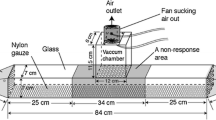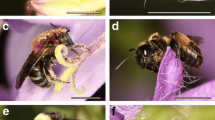Abstract
Male neotropical orchid bees (Euglossini) collect odoriferous substances from orchids and other sources and store them in tibial pouches, accumulating complex and species-specific bouquets. These fragrances are later exposed at display sites, presumably to attract females or conspecific males or both. We hypothesized that the necessity to detect and recognize specific fragrance bouquets has led to peripheral chemosensory specializations in different species of orchid bees. To test this, excised male antennae of four species of Euglossa were stimulated with complete tibial extracts of the same four species in a crosswise experiment. In the majority of the tested extracts, the amplitude of the electroantennogram (EAG) response was significantly different between species and always maximal in males of the extracted species. This effect did not appear to result from a given species' increased sensitivity toward certain attractive components: gas chromatography with electroantennographic detection (GC-EAD) of one extract of Euglossa tridentata evoked similar and generalized response patterns in all four species, encompassing a total of 34 peaks that elicited antennal responses. Therefore, the species effect in EAG responses to complete extracts likely resulted from species-specific interactions of compounds at the receptor level. Antennal specialization to conspecific bouquets adds additional strength to the argument that specificity is an important evolutionary aspect of euglossine tibial fragrances.


Similar content being viewed by others
References
J. D. Ackerman (1989) ArticleTitleGeographic and seasonal variation in fragrance choice and preferences of male euglossine bees Biotropica 21 340–347
R. P. Adams (2001) Identification of Essential Oil Components by Gas Chromatography/Quadrupole Mass Spectroscopy Allured Publishing Corporation Carol Stream, IL, USA
R. P. Akers W. M. Getz (1993) ArticleTitleResponse of olfactory receptor neurons in honeybees to odorants and their binary mixtures J. Comp. Physiol., A 173 169–185 Occurrence Handle10.1007/BF00192976
B. Bembé (2004) ArticleTitleFunctional morphology in male euglossine bees and their ability to spray fragrances (Hymenoptera, Apidae, Euglossini) Apidologie 35 283–291 Occurrence Handle10.1051/apido:2004013
S. I. Cromarty C. D. Derby (1997) ArticleTitleMultiple excitatory receptor types on individual olfactory neurons: implications for coding of mixtures in the spiny lobster J. Comp. Physiol., A 180 481–491 Occurrence Handle10.1007/s003590050065 Occurrence Handle1:CAS:528:DyaK2sXjt12isrs%3D
R. T. Dressler (1982) ArticleTitleBiology of the orchid bees (Euglossini) Ann. Rev. Ecolog. Syst. 13 373–394
T. Eltz K. Lunau (2005) ArticleTitleAntennal response to fragrance compounds in male orchid bees Chemoecology 15 135–138 Occurrence Handle10.1007/s00049-005-0303-y Occurrence Handle1:CAS:528:DC%2BD2MXhtFChsbnE
T. Eltz W. M. Whitten D. W. Roubik K. E. Linsenmair (1999) ArticleTitleFragrance collection, storage, and accumulation by individual male orchid bees J. Chem. Ecol. 25 157–176 Occurrence Handle10.1023/A:1020897302355 Occurrence Handle1:CAS:528:DyaK1MXhtVKisrk%3D
T. Eltz D. W. Roubik W. M. Whitten (2003) ArticleTitleFragrances, male display, and mating behaviour of Euglossa hemichlora—a flight cage experiment Physiol. Entomol. 28 251–260 Occurrence Handle10.1111/j.1365-3032.2003.00340.x Occurrence Handle1:CAS:528:DC%2BD2cXmt1Chtw%3D%3D
T. Eltz A. Sager K. Lunau (2005a) ArticleTitleJuggling with volatiles: exposure of perfumes by displaying male orchid bees J. Comp. Physiol., A 191 575–581 Occurrence Handle10.1007/s00359-005-0603-2
Eltz, T., Roubik, D. W. and Lunau, K. 2005b. Experience-dependent choices ensure species-specific fragrance accumulation in male orchid bees. Behav. Ecol. Sociobiol. 59:149–156.
G. Gerlach R. Schill (1991) ArticleTitleComposition of orchid scents attracting euglossine bees Bot. Acta 104 379–391 Occurrence Handle1:CAS:528:DyaK38XktVChsrw%3D
E. A. Hallem M. G. Ho J. R. Carlson (2004) ArticleTitleThe molecular basis of odour coding in the Drosophila antennae Cell 117 965–979 Occurrence Handle10.1016/j.cell.2004.05.012 Occurrence Handle1:CAS:528:DC%2BD2cXlsFWnu7s%3D Occurrence Handle15210116
L. S. Kimsey (1980) ArticleTitleThe behaviour of male orchid bees (Apidae, Hymenoptera, Insecta) and the question of leks Anim. Behav. 28 996–1004
W. L. Roelofs (1984) Electroantennogram assays: rapid and convenient screening procedures for pheromones H. E. Hummel T. A. Miller (Eds) Techniques in Pheromone Research Springer New York 131–160
D. W. Roubik P. E. Hanson (2004) Orchid Bees of Tropical America: Biology and Field Guide Instituto Nacional de Biodiversidad (INBio) Heredia, Costa Rica
F. P. Schiestl F. Marion-Poll (2002) Detection of physiologically active flower volatiles using gas chromatography coupled with electroantennography J. F. Jackson H. F. Linskens (Eds) Analysis of Taste and Aroma Springer New York 171–198
F. P. Schiestl D. W. Roubik (2003) ArticleTitleOdor compound detection in male euglossine bees J. Chem. Ecol. 29 253–257 Occurrence Handle10.1023/A:1021932131526 Occurrence Handle1:CAS:528:DC%2BD3sXjsl2gtg%3D%3D Occurrence Handle12647866
S. Vogel (1966) ArticleTitleParfümsammelnde Bienen als Bestäuber von Orchidaceen and Gloxinia Österr. Bot. Z. 113 302–361 Occurrence Handle10.1007/BF01373435
W. M. Whitten A. M. Young N. H. Williams (1989) ArticleTitleFunction of glandular secretions in fragrance collection by male euglossine bees J. Chem. Ecol. 15 1285–1295 Occurrence Handle10.1007/BF01014830 Occurrence Handle1:CAS:528:DyaL1MXit1yqtro%3D
W. M. Whitten A. M. Young D. L. Stern (1993) ArticleTitleNonfloral sources of chemicals that attract male euglossine bees (Apidae: Euglossini) J. Chem. Ecol. 19 3017–3027 Occurrence Handle10.1007/BF00980599 Occurrence Handle1:CAS:528:DyaK2cXhsFKlt7c%3D
N. H. Williams C. H. Dodson (1972) ArticleTitleSelective attraction of male euglossine bees to orchid floral fragrances and its importance in long distance pollen flow Evolution 26 84–95
N. H. Williams W. M. Whitten (1983) ArticleTitleOrchid floral fragrances and male euglossine bees: methods and advances in the last sesquidecade Biol. Bull. 164 355–395 Occurrence Handle1:CAS:528:DyaL3sXkvVGnu7Y%3D
Zimmermann, Y., Roubik, D. W. R., and Eltz, T. submitted. Species-specific attraction to pheromonal analogues in orchid bees.
Acknowledgment
We thank the staff of the Botanical Gardens of Düsseldorf and Ulm for their hospitality and assistance with beekeeping. T.E. wishes to thank Anna Sramkova for providing first guidelines for GC-EAD, Yvonne Zimmermann for her help with catching bees, and R. Kaiser and H. Budzikiewicz for help with compound identification. Financial support from the Deutsche Forschungsgemeinschaft (EL 249/2-1) is gratefully acknowledged.
Author information
Authors and Affiliations
Corresponding author
Electronic supplementary material
Rights and permissions
About this article
Cite this article
Eltz, T., Ayasse, M. & Lunau, K. Species-Specific Antennal Responses to Tibial Fragrances by Male Orchid Bees. J Chem Ecol 32, 71–79 (2006). https://doi.org/10.1007/s10886-006-9352-0
Received:
Revised:
Accepted:
Published:
Issue Date:
DOI: https://doi.org/10.1007/s10886-006-9352-0




